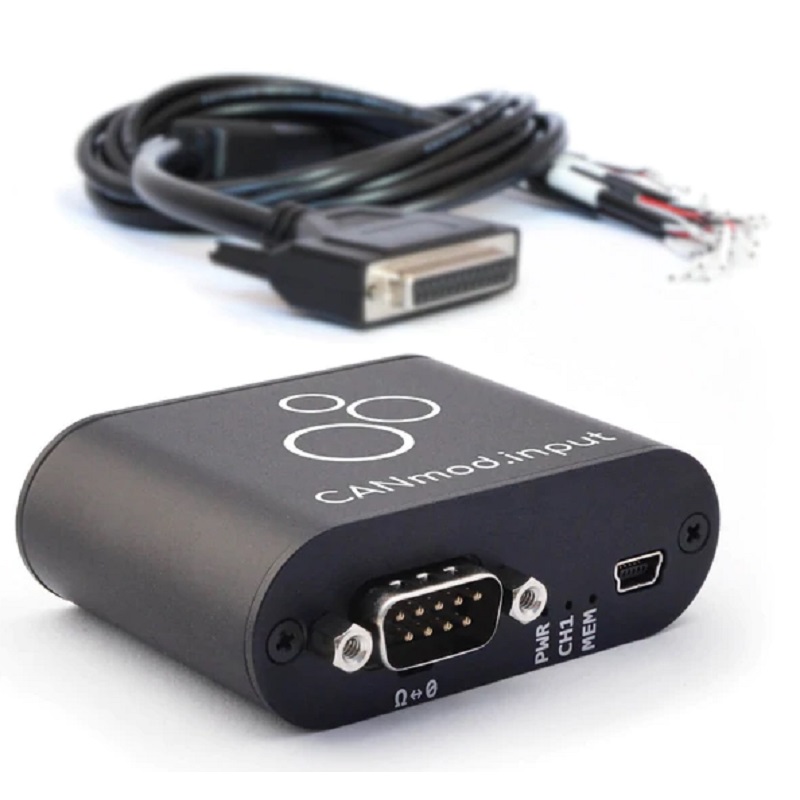
CANmod.input
Part No.: MPCSS-CANmod-input
8 x Analog/Digital/Pulse to CAN Bus Converter
Product Description
Description
This sensor-to-CAN module produces analog, digital & pulse measurements from 8 input channels - and outputs the data via CAN bus. The module is 100% standalone, no PC required.
The compact device offers pro specs incl. high accuracy and high-frequency sampling - as well as configurable input ranges and digital thresholds.
The module integrates with any CAN bus to provide data for ECUs or CAN tools. For example, you can use the module as an add-on for the CANedge.
Optionally add the DB25-to-input adapter.
Main Features
 |
Plug & Play Standalone - no PC required. Integrate with any CAN bus to add input sensor data. DBC included |
 |
Compact
7 x 2 x 5 CM. 70G. 8 LEDs. 5-26 V DC via DB9. 3.3V excitation signals. USB for config/FW/stream
|
 |
8 X Analog
8 analog input channels (1 kHz, 10 bit). Configurable voltage ranges (0-0.625V to 0-10V)
|
 |
+Digital
Digital input reading of each channel. 1 kHz. Configurable low/high/hysteresis
|
 |
+Pulse
Pulse input reading of each channel. 16 kHz. Frequency or counter mode (up to 32 bit)
|
 |
CONFIGURABLE
Configure sensors, CAN IDs, bit rate, frequencies and more via JSON config and GUI
|
Connect analog sensors

Easily add analog/digital/pulse data to any CAN bus system
Add analog/digital/pulse data via 8 input channels to your CAN bus - e.g. for use by ECUs or CAN hardware.
- Powerful parallel sampling of analog/digital/pulse signals
- Configure input range for optimal resolution/amplification
- Configure digital high/low levels incl. optional hysteresis
- Quickly connect sensors via optional DB25-input adapter cable
- Optionally output signals via CAN FD for fewer frames
- Daisy-chain multiple modules for 16, 24, 32, ... channels
- Dedicated excitation signal for powering input sensors (~3.3 V)
- Power device at 5-26 V DC via standard DB9 adapter cables
- Optionally record the data via any CAN interface/logger/...
- DBC file included for easy decoding to human-readable form
 |
The CANmod.input module lets you connect up to 8 analog, digital or pulse type sensors - and output the sensor data via configurable CAN frames into any CAN bus |
 |
You can install the CANmod.input 'standalone' in any CAN system (cars, trucks, ships, ...) to inject configurable CAN frames with input sensor data into the existing CAN traffic |
 |
The optional DB25-input adapter cable enables plug & play connection of a variety of sensors via open wires for each channel (isolated via heatshrinked pin headers) |
 |
The CANmod.input module can e.g. be used as a plug & play add-on for the CANedge (powered via 2nd port) - letting you combine CAN/LIN data with timesynced analog/digital/pulse data |
 |
The CANmod.input offers vast functionality and pro specs - yet it is extremely compact, measuring only 7 x 2 x 5 CM and weighing just 70 G |
 |
The CANmod.input can be configured via the USB connector using our online/offline config editor tool (or a simple JSON text editor) |
 |
The CANmod.input measures both the analog, digital and pulse signal of every channel, enabling powerful analyses and high flexibility (picture from the asammdf GUI) |
 |
You can easily mix and daisy chain multiple CANmod modules, thus adding different sensor types and/or more channels |
Example: Log/stream sensor data
The CANmod.input is often used as an 'add-on' for the CANedge. This setup lets you record e.g. vehicle data via Channel 1 and analog/digital/pulse data via Channel 2. The data can be easily DBC decoded via e.g. the asammdf GUI, Python or MATLAB.
You can also stream the sensor data in real-time via USB using SavvyCAN to view raw/decoded data (e.g. via plots) - ideal for validating your setup pre-deployment or for lab testing.
Technical Specifications
GENERAL |
||
|
Functionality
|
The device produces analog/digital/pulse data from 8 input sensors and outputs via CAN/USB
|
|
|
Included
|
CANmod.input module and USB dust cover (input sensors and mini USB adapter not included)
|
|
|
Firmware
|
Supports free firmware updates via USB for adding features
|
|
|
Configuration
|
Configuration files based on the popular open source JSON schema concept (similar to the CANedge)
|
|
|
Software
|
Free open source editor tool for easy device configuration (offline/online version available)
|
|
|
Safety
|
CE, FCC, IC and RoHS certified
|
|
|
Warranty
|
1-year warranty
|
|
|
Support
|
Free, fast & high quality support
|
|
|
Origin
|
Denmark
|
|
SENSOR (INPUT) |
||
|
Channels
|
Supports 8 input channels
|
|
|
Sensor Types
|
All 8 input channels support analog, digital and pulse-type sensors
|
|
|
Sampling Method
|
Each input channel samples both the analog, digital and pulse signal of the connected sensor
|
|
|
Input Range
|
|
|
|
Resolution
|
10 bit
|
|
|
Sampling Frequency
|
Analog inputs: 1 kHz | Digital: 1 kHz | Pulse (frequency/counter): 16 kHz
|
|
|
Digital Thresholds
|
Configurable digital high/low switch thresholds (0-100%) incl. optional dead-zone/hysteresis
|
|
|
Pulse Modes
|
Pulse inputs can be measured as frequencies (reset) or counters (accumulate) | |
|
Pulse Resolution
|
Up to 32 bit (4,294,967,294) | |
|
Input Impedance
|
136K
|
|
DATA PARANETERS |
||
|
CAN Signals
|
|
|
CAN BUS |
||
|
Channels
|
1 x CAN channel
|
|
|
Modes
|
The device can either broadcast the data onto the CAN bus - or provide it on-request
|
|
|
Standard
|
ISO 11898 : Compliant with CAN (between 5K and 1 Mbit/s baud rates) and CNA FD (1M, 2M, 4M)
|
|
|
Identifiers
|
Compliant with CAN specifications 2.0A (11-Bit ID) and 2.0B (29-Bit ID)
|
|
|
Termination
|
Termination can be toggled via switch below DB9 connector | |
|
Retransmission
|
Retransmission of frames that have lost arbitration or been disturbed by errors
|
|
|
Transceiver Protection
|
|
|
CONGIGURATION |
||
|
Bit Rate
|
Select between standard bit rates (5K to 1M) or use custom bit-timing
|
|
|
Enable/Disable
|
Individually enable/disable each CAN message
|
|
|
Identifier Customization
|
Individually configure each CAN ID (11-bit or 29-bit)
|
|
| Push/Poll Mode | Individually configure 'trigger' modes for each CAN message (push or poll) | |
|
Frequency
|
Individually configure prescaling of each CAN message frequency to lower rates
|
|
ELECTRICAL |
||
|
Input Supply
|
|
|
| Power Consumption | Extremely low (<1W) - no risk of battery drainage | |
|
Protection
|
|
|
MECHANICAL |
||
| Encloseure & Weight |
Compact aluminium enclosure : 52.5 x 70.0 x 24.5 mm (L x W x H), 70 grams
|
|
|
Connector (Front)
|
1 x Standard D-Sub 9 (DB9) connector
|
|
|
Connector (Back)
|
1 x D-Sub 25 (DB25) connector
|
|
|
Sensor Supply
|
Dedicated excitation signals for each channel (~3.3 V, shared max of 100 mA)
|
|
|
Pin-Out
|
See the product manual for the DB9/DB25 connector pin-outs
|
|
|
USB
|
Standard mini USB connector for config/firmware updateds and streaming (USB cable not included)
|
|
|
LEDs
|
Module status via 8 external LEDs : Power, CAN bus, Memory, Status, CH1/CH2, CH3/CH4
|
|
|
Temperature
|
Operating temperature (CANmod.input module): -25degC to +70degC
|
|
|
IP Rating
|
IP Rating 40
|
|
|
Mounting
|
Module can be mounted via e.g. rugged double-sided tape, zip-ties or a mounting bracket
|
|
Use Cases
The CANmod.input can be installed standalone in any CAN bus system - including e.g. as an add-on for the CANedge.
Add analog/digital/pulse signals to your CAN bus
Need to inject sensor data directly into your CAN bus?
The input-to-CAN module can be used standalone to inject CAN frames with analog/digital/pulse sensor measurements into e.g. your vehicle/machine CAN bus system. The data can be consumed by other CAN nodes on the network - e.g. ECUs, cabin displays, CAN loggers or telematics control units (TCU). To ensure compatibility, you can modify the module output bit rate and CAN IDs via the simple GUI config editor. The module is ideal for e.g. prototype vehicle testing, automotive/industrial development and more.
CAN + sensor data logging & telematics
The CANmod.input can be deployed as an 'add-on' module for the CANedge. Simply configure the CANedge to provide a 5V power out via the 2nd port - and connect the CANmod.input via the optional adapter cable. This lets you log e.g. vehicle CAN bus data via channel 1 and time-synced analog/digital/pulse data via channel 2. Data can be offloaded periodically when the asset is within WiFi range - e.g. via a warehouse or garage WiFi router.
On-road telematics with CAN + GNSS/IMU data
Need to upload CAN bus and GNSS/IMU data via 3G/4G?
The CANedge2 can upload data while on-the-road using e.g. a 3G/4G USB router. You can power the 3G/4G hotspot from the vehicle - or use our DB9-DB9/USB adapter to power both the hotspot and CANmod.input voltage recorder via the 2nd port of the CANedge2. The uploaded log files can e.g. be visualized in telematics dashboards. Ideal for e.g. 'sensor telematics' use cases like predictive maintenance, remote diagnostics and more. You can of course also daisy chain other CANmod modules like the temperature-to-CAN and GPS-to-CAN modules.
Daisy-chaining input modules
Need a larger number of sensor input channels?
The CANmod.input is extremely simple to setup and configure. With easily customizable CAN frame IDs you can quickly daisy-chain several modules to add 8, 16, 24, ... analog/digital/pulse inputs to your CAN bus (e.g. using DB9-Y-splitters). Every individual input channel can be independently configured - allowing for complete customization. If you wish to record the data to a CAN bus data logger, you can use the CANedge to easily power a full chain of modules via the 2nd port.



